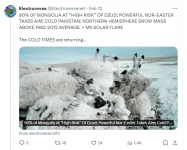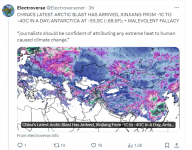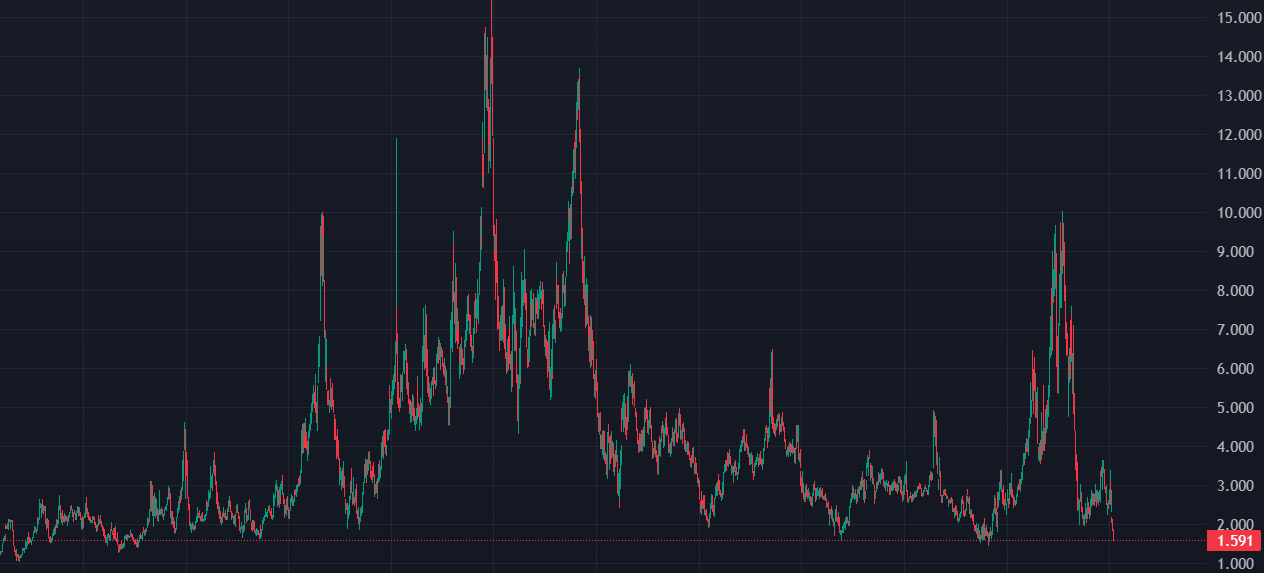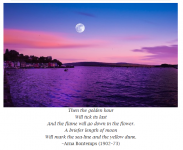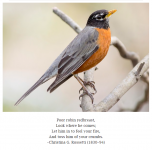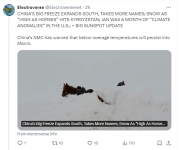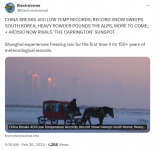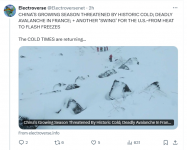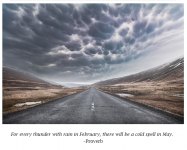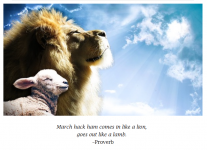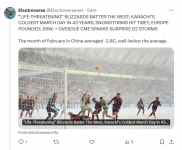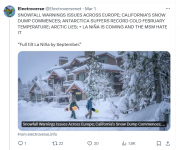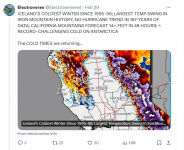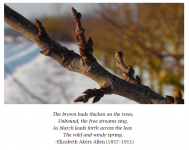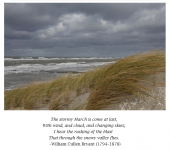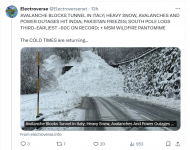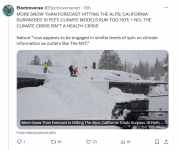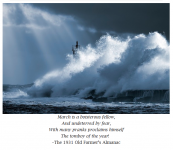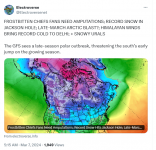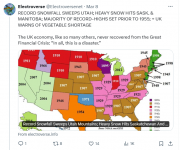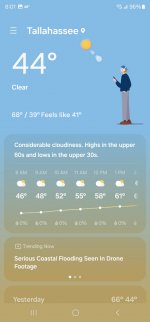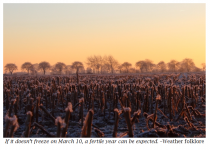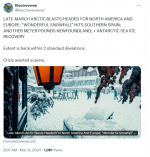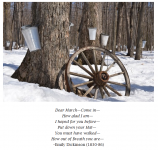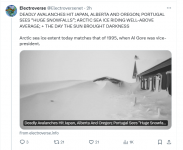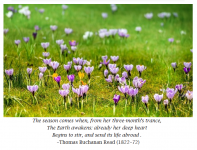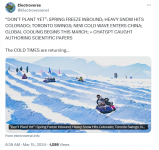The Little Ice Age was brutal. How did people survive?
From roughly the 16th to 19th centuries, much of the Earth was gripped by a persistent frigid cold. It left ripples through history—and some lessons for today’s climate crisis.
During the Little Ice Age, the Northern Hemisphere experienced long stretches of temperatures so cold that crops failed and rivers froze—like the Scheldt River, depicted here outside of Antwerp, Belgium, in a 1593 oil painting by Lucas van Valckenborch.
PHOTOGRAPH BY INCAMERASTOCK, ALAMY STOCK PHOTO
BY KIERAN MULVANEY
National Geographic
PUBLISHED FEBRUARY 20, 2024
Thousands of people walking and playing across the frozen River Thames. Soldiers on horseback capturing ships stuck in the ice. Indigenous populations using snowshoes to outfox English interlopers. Accused witches put on trial as their communities struggled to explain crop failures and extreme cold.
These were some of the images that define the Little Ice Age—a period of several centuries last millennium in which parts of the Northern Hemisphere grappled with a persistent cold. But what caused the Little Ice Age, how long did it last, how did people adapt to its frigid grip—and what lessons can we learn as we enter our own period of climatic change?
What is the Little Ice Age—and what caused it?
The Little Ice Age was not a
true ice age—average cooling was probably only in the order of
0.5 degrees Celsius, or 1 degree Fahrenheit—nor was it consistently cold. Dagomar Degroot, associate professor of environmental history at Georgetown University and author of
The Frigid Golden Age has referred to the era as a series of “little little ice ages.”
Although some researchers argue it may have begun earlier,
NASA defines the Little Ice Age as beginning around 1550 and consisting of three cold peaks—around 1650, 1770 and 1850—interspersed with relative warm intervals.
Scientists are still working out exactly what caused the Little Ice Age too. Theories range from
decreased solar activity to
increased volcanic eruptions, to the
genocide of Indigenous populations in North America, which allowed forests to replace agricultural land, in the process removing about seven billion tons of carbon from the atmosphere. A 2022 study argued that the initial trigger was, counterintuitively,
a surge of extremely warm water flowing north from the tropics in the late 1300s, which flushed Arctic ice into the North Atlantic.
Widespread impacts
Whatever the cause, the consequences of the Little Ice Age
have rippled through history, although to what extent is controversial.
Certainly, cold weather enabled Charles X Gustav of Sweden to march his troops across a frozen strait
to capture the Danish island of Funen in 1658, and made it possible for French troops to seize a Dutch fleet that had frozen into the ice in 1795—an event described as being
the only time in history men on horseback captured a fleet of ships. Fear and anxiety at repeated crop failures
prompted a surge of “witch trials” and
anti-Semitism in Europe.
Less definitively,
the Little Ice Age may have played a role in the collapse of the Ming Dynasty in China, partly as a result of
food shortages leading to peasant uprisings. The drop in temperatures and a simultaneous growth in ice cover on land and sea
may have contributed to the disappearance of Norse colonies from Greenland. It has even been postulated that the unique sound of Stradivarius violins results from the wood that Antonio Stradivari used being
denser than usual because of the cold.
Beyond the grand historical ripples it may have set in motion, the Little Ice Age had particularly severe impacts on the peasantry and the urban poor. In his book
The Little Ice Age, author Brian Fagan describes “Alpine villagers [living] on bread made from ground nutshells mixed with barley and oat flour.” A
1648 account recorded the “cryes and teares of the poore, who professe they are almost ready to famish.”
Parts of the 17th and early 18th centuries were especially brutal.
Several European nations underwent major famines in the late 1600s; according to
Ariel Hessayon of Goldsmiths, University of London, the winter of 1684 was so severe that King Charles II authorized a charitable collection, to which he himself contributed. That enabled England to withstand the winter better than some of its neighbors; even so,
Hessayon writes, “people died throughout the land, as did beasts, birds and fish. Burials were suspended because the ground was too hard to dig up.
Trees split apart and plants perished.”
Adapting to the cold
Remarkably, some were able to adapt to the hardships. In London, the cold conditions caused the River Thames to freeze over on multiple occasions, to the extent that “frost fairs” would spring up, with people playing soccer, watching bearbaiting, or competing in archery contests amid a backdrop of stalls selling everything from hot chocolate to pies.
The freezing of the Thames might have spelled disaster for the city’s
watermen, who “essentially offered a water taxi service along the river,” Hessayon explained in an interview. In response, he says, they took advantage of the frost fairs to develop alternative income streams: “They adapted, because they would become shopkeepers on the ice, and they wouldn’t have to pay rent on the frozen Thames.”
Meanwhile the Mojave people
in modern-day California responded to greater climatic variability in the 16th and 17th centuries by
“developing a remarkably decentralized trading culture,” says Degroot. They also created resilient baskets, pottery, and other containers to transport goods over long distances,
“so that if there was a food shortfall in one region, they could compensate by trading with another.”
The Mojave’s response to the changing climate was mirrored several thousand miles away by the Dutch Republic, which
actually enjoyed a “golden age” during the Little Ice Age’s most challenging years—largely, Degroot explains, by also developing a resilient and diverse trading infrastructure.
“They were able to transport commodities from many different regions—including, most importantly, grain from different ports in the Baltic,” he says. As a result, when extreme weather caused a grain shortfall, “the Dutch were actually able to exploit that by importing commodities from places where they were grown.”
In New England, the Wabanaki Nations took advantage of cold and snowy winters by using snowshoes to launch raids against English colonists—until, in the early 18th century, the interlopers adopted the Indigenous technology and expertise and
sent out hundreds of “snowshoe men” to patrol Wabanaki hunting grounds.
Modern-day lessons
Surprisingly, says Degroot, one area where commerce improved and conflict lessened was the whaling grounds of the Arctic. “When it got colder and ice expanded, resources were more tightly packed together and more accessible,” he explains. As a consequence, he continues, the armed conflict that had characterized Arctic whaling actually diminished.
There might be a lesson in there for modern-day climate change watchers, he says, adding that it “is really the exact opposite of how the Arctic is often discussed in national security circles today, where people assume that as the Arctic thaws, there might be much more competition and conflict in the region.”
As significant as the effects of the Little Ice Age were, however, Degroot notes that the amount of cooling was less than the extent of warming
we are presently experiencing. Hessayon argues this makes understanding the period and how people adapted even more important.
“There is a huge amount of potential material that we can study and learn a great deal about the past and hopefully inform how to deal with our current crisis,” he explains.
From roughly the 16th to 19th centuries, much of the Earth was gripped by a persistent frigid cold. It left ripples through history—and some lessons for today’s climate crisis.

www.nationalgeographic.com

en.wikipedia.org

